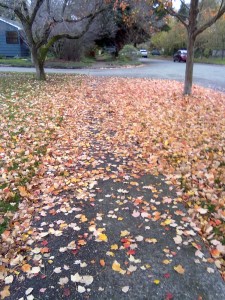 While it feels more like winter than Autumn here in Seattle (22 F and -8 C I think, 6-8 inches of snow on the ground) I watch the last of the leaves falling off the big horse chestnut at the end of our driveway. Harvest time. While I’ve put my garden to bed for the winter, the chickens are still giving us a few eggs and all the pickles and chutneys we cooked up earlier in the Fall are looking beautiful on the shelf. The harvest.
While it feels more like winter than Autumn here in Seattle (22 F and -8 C I think, 6-8 inches of snow on the ground) I watch the last of the leaves falling off the big horse chestnut at the end of our driveway. Harvest time. While I’ve put my garden to bed for the winter, the chickens are still giving us a few eggs and all the pickles and chutneys we cooked up earlier in the Fall are looking beautiful on the shelf. The harvest.
I posted a few days ago about reflective teacher practices. Reflection is a form of harvest. Debriefing an experience is another form that I am particularly appreciating these days. Each of these processes has a potential internal and external value. I wanted to point out some examples of how people have shared out their harvest on blogs, tweets, and other social media to create external value.
Via Nadia Manning-Thomas of the CGIAR ICT-KM program shared two after event reflections on their blog, one on a particular activity design and debrief of a social media workshop. Nadia’s posts were thoughtful and probably took a fair amount of time to weave together – full of links, photos and content.
Chris Corrigan has an amazing range of harvest approaches from the very deep to the light and poetic, haiku-like practices.
Harold Jarche who is great at sharing his reflections, captured a quick post workshop blog post. Not everything needs to be polished and for busy people, sometimes the quick share is the quick win for the rest of us.
Immediately after the workshop, I wrote, So what did I learn or what was reinforced?
A loose-knit online learning community can scale to many participants and remain effective.
Only a small percentage ~10% of members will be active.
Wikis need to be extremely focused on real tasks/projects in order to be adopted.
If facilitators can seed good questions and provide feedback, then conversations can flourish.
Use a very gentle hand in controlling the learners and some will become highly participative.
Design for after the course, using tools like social bookmarks, so that artifacts can be used for reference or performance support.
Create the role of “synthesizer”. I found it quite helpful when Tony and Michele summarized the previous week’s activities.
Keep the structure loose enough so that it can grow or change according to the needs of the community.
Having worked with many other online communities in the past two years, I would say that the role of “synthesizer” remains important, and it is a critical part of being a good online community manager.
I’m currently coming to the final phase of a formal evaluation which has lots of reflection, tons of things we’ve harvested, and now we are trying to figure out how to make them valuable. How can this “harvest” feed, rather than rot in a pile? Any inspirations for me?
Hello Nancy,
Within the Art of Hosting community we had recently a conversation around what is the essence of a good harvest? We thought that it was – besides creating a collective memory – to create collective meaning making.
How could you do that with the pile of things that you have right now? I don’t have the answer, but I thought I could share the question?
Good question, Ria. I realized as I chewed on your question that I have two phases (at least) in my head about meaning making. The first it the meaning making that the harvesters accrue. The act of harvesting implies some sort of selection and meaning making. The second is what happens AFTER harvest, the deliberate act (or accidental) of meaning making. Individually. Collectively. With intent and stuff that “just happens!”
To follow up on this… You say: “the act of harvesting implies some sort of selection….” but more important is – I guess – that in the act of harvesting you look for the bigger picture, the red threads, the patterns that show themselves…
Often the reflections of processes I wasn’t part of don’t make too much sense.. It comes in like information (I do tag these often!). The value is in personal reflection- looking back at what happened and trying to make sense and in collective reflection (AAR type) which gives you a view of how others experienced it. For others, it often needs some translation (l find myself agreeing with all Nancy Dixon has written about this)
That makes sense to me Joitske. I think Nadia has been paying attention to how “non participants” receive the harvest. Maybe we need to think more broadly/with more diversity of types of harvest?